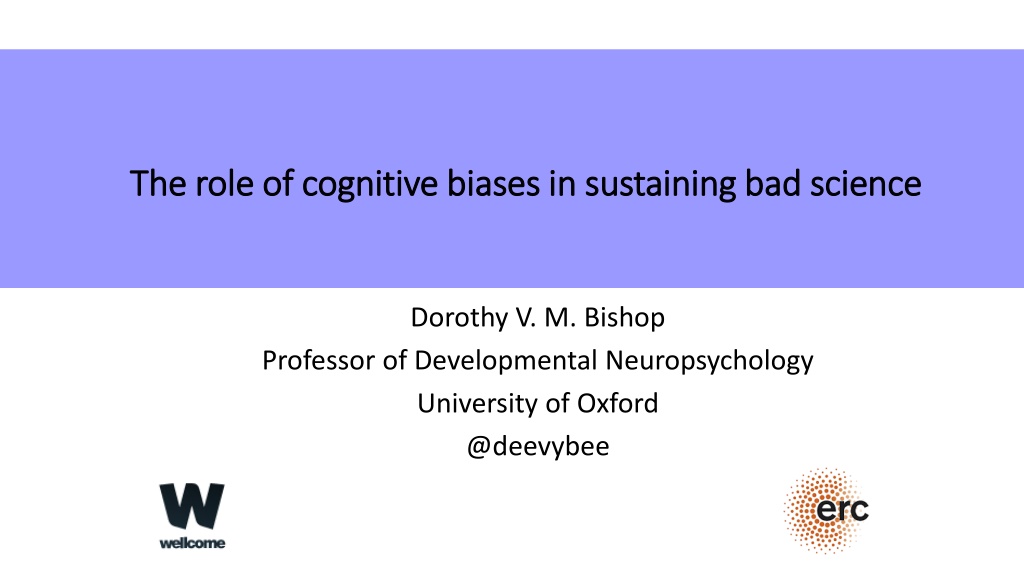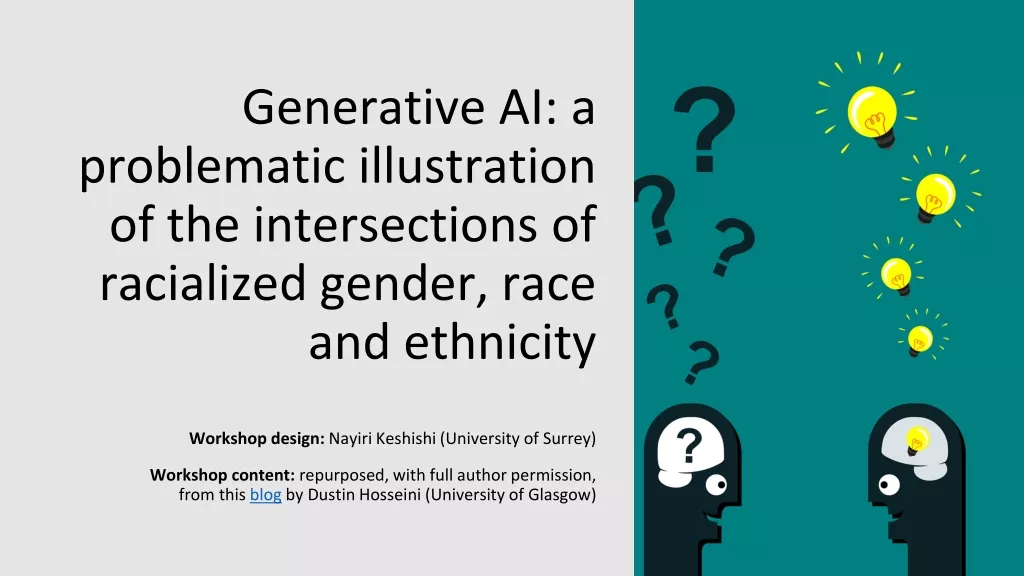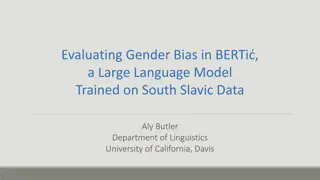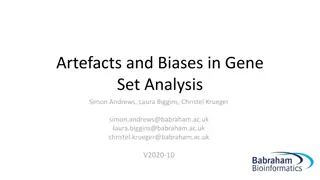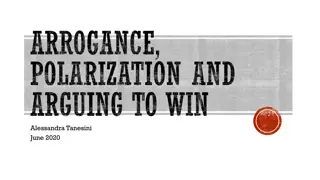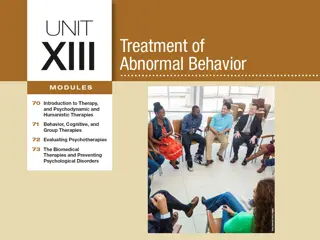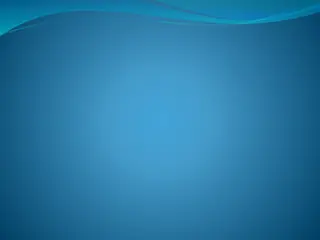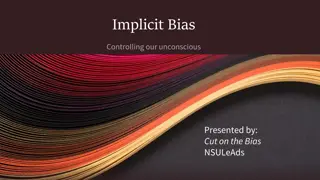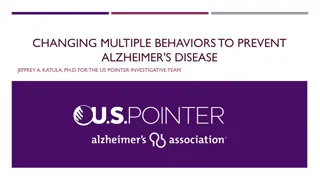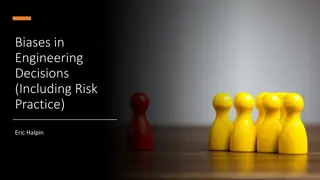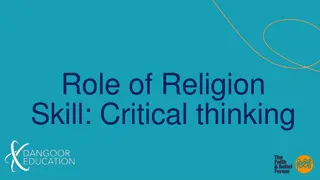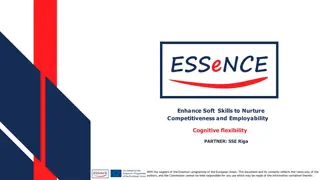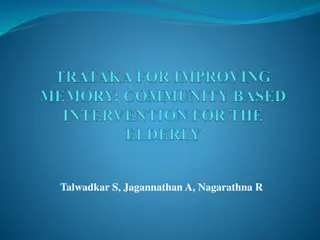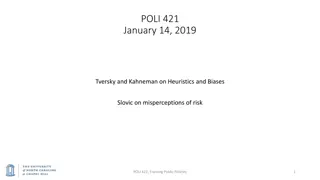Cognitive Biases in Sustaining Bad Science
Cognitive biases play a significant role in perpetuating bad science by influencing the way research is conducted. Inaccurate interpretations of data, confirmation bias, and selective attention/memory can lead to flawed conclusions. The Academy of Medical Sciences highlights the need for better training in research methods to improve reproducibility and reliability in biomedical research. Cognitive constraints such as seeing patterns in noise and misunderstanding probability further complicate scientific endeavors. P-hacking is a common issue in data analysis, impacting the validity of research findings. Examples of using large population databases to explore associations like ADHD and handedness shed light on the challenges of interpreting statistical results.
Download Presentation

Please find below an Image/Link to download the presentation.
The content on the website is provided AS IS for your information and personal use only. It may not be sold, licensed, or shared on other websites without obtaining consent from the author.If you encounter any issues during the download, it is possible that the publisher has removed the file from their server.
You are allowed to download the files provided on this website for personal or commercial use, subject to the condition that they are used lawfully. All files are the property of their respective owners.
The content on the website is provided AS IS for your information and personal use only. It may not be sold, licensed, or shared on other websites without obtaining consent from the author.
E N D
Presentation Transcript
The role of cognitive biases in sustaining bad science The role of cognitive biases in sustaining bad science Dorothy V. M. Bishop Professor of Developmental Neuropsychology University of Oxford @deevybee
Academy of Medical Sciences, 2015 Report on Reproducibility and Reliability of Biomedical Research Need to change incentives Possible solutions: Emphasis on both bottom-up and top-down changes Data dredging Omitting null results Weak experimental design Underspecified methods Errors (e.g. faulty equipment) Underpowered studies Need better training in methods 2
Cognitive constraints that can make it hard to do science well Seeing patterns in noise Systematic misunderstanding of probability Schemata: Need for narrative Asymmetric moral judgements Confirmation bias: selective attention/memory
Cognitive constraints that can make it hard to do science well Seeing patterns in noise Systematic misunderstanding of probability Schemata: Need for narrative Asymmetric moral judgements Confirmation bias: selective attention/memory
Data analysis Why is p-hacking so common? 5
Large population database used to explore link between ADHD and handedness 1 contrast Probability of a significant p-value < .05 = .05 6 https://figshare.com/articles/The_Garden_of_Forking_Paths/2100379
Large population database used to explore link between ADHD and handedness Focus just on Young subgroup: 2 contrasts at this level Probability of at least one significant p-value < .05 under null hypothesis computed as 1 minus probability of NO significant result, i.e. 1 - .95^2 = .10 NB. If I had predicted this specific association, then probability = .05. Problem arises if I am happy with ANY significant association! 7
Large population database used to explore link between ADHD and handedness Focus just on Young on measure of hand skill: 4 contrasts at this level Probability of at least one significant p-value < .05 = .19 8
Large population database used to explore link between ADHD and handedness Focus just on Young, Females on measure of hand skill: 8 contrasts at this level Probability of at least one significant p-value < .05 = .34 9
Large population database used to explore link between ADHD and handedness Focus just on Young, Urban, Females on measure of hand skill: 16 contrasts at this level If no a priori prediction, then the relevant value to compute is the probability of at least one significant p-value < .05 = .56 10
Falsification and selective reporting (p-hacking) in science % moral judgements endorsed by members of public (N = 406) Falsification Selective reporting 71 63 73 37 Morally unacceptable Should be fired Should receive funding ban 93 Should be a crime 96 96 66 Pickett, J. T., & Roche, S. P. (2018). Questionable, objectionable or criminal? Public opinion on data fraud and selective reporting in science. Science and Engineering Ethics, 24(1). doi:10.1007/s11948-017-9886-2 11
Errors of omission vs commission in studies of negotiation by Rogers et al (2016) Omission of information seen as dishonest, but more acceptable than lying Honesty judgement 5% Lying (untrue statement) 23% Omission of relevant information 32% Stating something that is true, but in a misleading way (paltering) Rogers, T., Zeckhauser, R., Gino, F., Norton, M. I., & Schweitzer, M. E. (2017). Artful paltering: The risks and rewards of using truthful statements to mislead others. Journal of Personality and Social Psychology, 112(3), 456-473. 12
Errors of omission vs commission in studies of negotiation by Rogers et al (2016) Omission of information seen as dishonest, but more acceptable than lying Honesty judgement 5% Lying (untrue statement) 23% Omission of relevant information 32% Stating something that is true, but in a misleading way (paltering) P-hacking has features of paltering. Doesn t involve changing data: you report what SPSS gives you! If you don t understand probability, may seem innocuous - More like jaywalking than burglary! 13
Cherry-picking as confirmation bias We find it easier to process and remember information that agrees with our viewpoint 15
A personal example: Suppressed memory of relevant research, when it does not fit Twin studies of Developmental Language Disorder probandwise points to genetic influence when MZ > DZ Twin concordance concordance: same-sex twins MZ DZ Lewis & Thompson, 1992 Bishop et al, 1995 Tomblin & Buckwalter, 1998 Hayiou-Thomas et al, 2005 .86 .70 .48 .46 .69 .96 .36 .33 16
A personal example: Suppressed memory of relevant research, when it does not fit Twin studies of DLD Twin concordance points to genetic influence when MZ > DZ probandwise concordance: same-sex twins MZ DZ Lewis & Thompson, 1992 Bishop et al, 1995 Tomblin & Buckwalter, 1998 Hayiou-Thomas et al, 2005 .86 .70 .48 .46 .69 .96 .36 .33 I failed to mention this in talks for several years I literally forgot about it! 17
Example of paltering in a literature review Example: Study published in 2013 Regardless of etiology, cerebellar neuropathology commonly occurs in autistic individuals. Cerebellar hypoplasia and reduced cerebellar Purkinje cell numbers are the most consistent neuropathologies linked to autism [8, 9, 10, 11, 12, 13]. MRI studies report that autistic children have smaller cerebellar vermal volume in comparison to typically developing children [14].
Meta-analysis: Traut et al (2018) https://doi.org/10.1016/j.biopsych.2017.09.029 Standardized mean difference is +ve when cerebellar volume is greater in ASD Webb et al did find area of vermis smaller in ASD after covarying cerebellum size
Just as with reporting of results, omission/paltering in reporting the literature is not seen as serious Can be unintentional hard to establish blame Need to tell a good story in limited space Social pressures ( everyone is doing it ) 20
Just as with reporting of results, omission/paltering in reporting the literature is not seen as serious Can be unintentional hard to establish blame Need to tell a good story in limited space Social pressures ( everyone is doing it ) Impossible to read everything No obvious victims Impact assumed to be small 21
Biased reporting: How big is the effect? 22
Consider a series of experiments testing effectiveness of a treatment Y = significant difference in favour of treatment (T ) N = nonsignificant difference between T and control Alpha = .05: probability of Y when T has no effect = .05 probability of N when T has no effect = .95 Power = .8 probability of Y when T is effective = .80 probability of N when T is effective = .20 At the outset, you think T has a 50:50 chance of working What would you conclude from this series of results: Y N Y N N Y 23
When sequence of 'significant' results is Y N Y N N Y 1. Treatment very likely to be ineffective 2. Treatment may be effective, but need more experiments to be sure 3. Treatment very likely to be effective 24
Log odds of 3 means 20 times more likely to be effective than ineffective Sequence is: Y N Y N N Y A: Treatment very likely to be ineffective B: Treatment may be effective, but need more experiments to be sure C: Treatment very likely to be effective 25
When sequence of 'significant' results is Y N N N Y N N N Y N 1. Treatment very likely to be ineffective 2. Treatment may be effective, but need more experiments to be sure 3. Treatment very likely to be effective 26
Sequence is: Y N N N Y N N N Y N Trials in red not reported/not cited A: Treatment very likely to be ineffective B: Treatment may be effective, but need more experiments to be sure C: Treatment very likely to be effective 27
Sequence is: Y N N N Y N N N Y N Trials in red not reported/not cited A: Treatment very likely to be ineffective B: Treatment may be effective, but need more experiments to be sure C: Treatment very likely to be effective 28
Sequence is: Y N N N Y N N N Y N Black line shows situation when p-hacking used, so that effective alpha is .2 rather than .05 A: Treatment very likely to be ineffective B: Treatment may be effective, but need more experiments to be sure C: Treatment very likely to be effective 29
Silas Boye Nissen, Tali Magidson, Kevin Gross, Carl T Bergstrom 30
Silas Boye Nissen, Tali Magidson, Kevin Gross, Carl T Bergstrom Or citation! 31
Inheritance of bias When we read a peer-reviewed paper, we tend to trust the citations that back up a point When we come to write our own paper, we cite the same materials A good scientist won t cite papers without reading them, but even this won t save you from bias you inherit it from prior papers If prior papers only cite studies agreeing with a viewpoint, that viewpoint gets entrenched You won t know unless you explicitly search that there are other studies that give a different picture 32
So errors of omission/paltering in reviews can have serious cumulative effects false canonization of facts Overlooked victims: General public Esp. potential users of research (patients, etc) Researchers trying to build on results Funders 33
The (partial) solution from clinical trials Always start work in a new area with a systematic review Systematic review Collecting and summarise all empirical evidence that fits pre-specified eligibility criteria to address a specific question But relevant studies found by searching titles and abstracts. These tend to mention only positive results! 34
Classic p-hacking Study looked at association with autism for many occupational exposures for both parents, and found none survived Bonferroni correction. Abstract just reported the one result that was significant A systematic review of other substances (e.g. pesticides) would not find the null results from this study when screening Abstracts
Academy of Medical Sciences, 2015 Report on Reproducibility and Reliability of Biomedical Research Need to change incentives Data dredging Omitting null results Weak experimental design Underspecified methods Errors (e.g. faulty equipment) Underpowered studies Need better training in methods 36
Need to change incentives What s missing? How humans think & reason Data dredging Omitting null results Find ways to counteract cognitive biases Weak experimental design Underspecified methods Errors (e.g. faulty equipment) Underpowered studies Need better training in methods 37
Thank you for listening! Longer written version: https://psyarxiv.com/hnbex/ Other slideshows: https://www.slideshare.net/deevybishop Blogposts: http://deevybee.blogspot.com/2012/11/ bishopblog-catalogue-updated-24th-nov.html Professor Dorothy Bishop Department of Experimental Psychology, Anna Watts Building, Woodstock Road, Oxford, OX2 6GG. @deevybee 38
